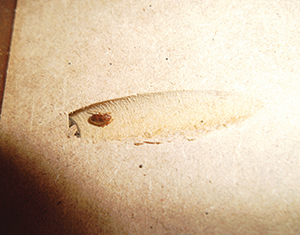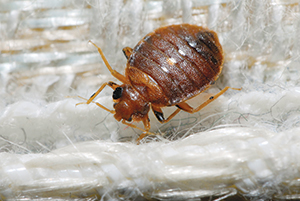Which spreads more bed bugs: Visiting infested hotels or picking up discarded furniture? It has been a long time since I snagged a couch or chair off the curb, but I stay in hotels regularly. I used to perform an exhaustive inspection of every hotel room before I slept in it. Recently, though, it has become apparent such rigorous precautions are overkill in many areas of the country.

Pictured above is the lone bed bug specimen the author encountered in his hotel room. Photo: Mark Sheperdigian
I still inspect every room, but I no longer invert every piece of furniture or separate every pleat in the drapes. I’m content to check the headboard, mattress and box spring edges, baseboards, and behind the nightstand sometimes. If I see evidence of bed bugs, I’ll insist on another room, but I don’t have to examine every crevice (with the toothpick I just found) to sleep well.
I’ve only found a live bed bug in a hotel room once. I checked in and searched for bed bugs before my roommate arrived. I was tempted to just quit after I inspected my bed, but a deeply ingrained sense of loyalty and duty urged me to check his bed, too. I almost finished the inspection when I saw several small dark specks that looked like bed bug spots. Sure enough, there, in an angle pocket hole, was a single live adult male bed bug. “Great,” I thought. “Now I’ll have to see the manager, tell my tale, move my bags and conduct another bed bug check in a new room — all with little guarantee this was the only bed bug in the hotel.” Of course, it also occurred to me this bed bug wouldn’t bypass my roommate in this bed to go all the way over to bite me in my bed. That’s when the inner conflict started:
Angel on my right shoulder:
“Go on, report it. It’s the right thing to do.”
Devil on my left shoulder: “It’s on his bed. He won’t feel it. He hardly reacts at all. You don’t have to outrun the bear, you just have to outrun him.”
Relax! I did the right thing. I called the manger, and he graciously gave us another room and watched as I inspected it. Naturally, I had to inspect much more carefully than I usually do because someone was watching.

Heavy infestations are more likely to spread bed bugs than light infestations. Photo courtesy of, and copyrighted by, Gene White, pmimages@earthlink.net
Some bugs are an island
The bed bug I found in the first room was an adult male, and the small, granular droppings suggested he hadn’t eaten since he arrived at the headboard. He was alone and unable to get anything started by himself. He may have bitten a guest or two, but most people barely react and would never even know. Without a mate, this was one lonely old bugger who was doomed to live out his days in a quiet hotel room, getting thinner and thinner until he expired like an unfed parking meter.
Most hitchhiking bed bugs go this way. They get out the door well enough, but then they’re faced with a series of choices — many of which end in disaster. The species appears to turn on numbers, and if enough hitchhikers leave a heavily infested home, at least some new infestations will start. It’s bound
to happen.
On the other hand, if bringing one bed bug home on your clothes is sure to start an infestation, we’d see it among those of us who visit heavily infested homes regularly. There is an amazingly small number of technicians who’ve had their homes infested, despite working with bed bugs every day. It seems to take repeated attempts before all the conditions are just right, but once an infestation starts, it can grow to outrageous proportions for three to six months. This makes sense, but it’s not supported by science yet. Hopefully, research will be able to explain what puzzles us daily and prove what we might already know to be true.
Control vs. Overkill
When the bed bug resurgence was still fresh, and related urban myths spread faster than a nasty rumor through social media, we thought bed bugs could be contracted by casual contact. We took more precautions than you can find printed on a ladder approved by the Occupational Safety & Health Administration. From Tyvek suits and prophylactic pant-leg spraying to arguably obscene self-checks after working in a heavy infestation, we often exert more effort trying to prevent our own infestation than we do trying to kill the bed bugs in the first place.
As it turns out, we might have been a little paranoid at the prospect of getting bed bugs ourselves. In the 10 to 15 years since then, we’ve grown weary of all the extra steps and the hassle of all the safeguards, but many dare not leave out one step. Because of this, it’s worthwhile to point out two truths about bed bugs:
1. Getting infested by bed bugs isn’t as easy as entering a room where they’re present.
2. Heavy infestations are more likely to spread bed bugs than light infestations.
Of all the steps we take, the most important precautions involve working in heavy infestations. Anything you bring in and set down while you work should be checked or separated after the job. It can also be helpful to leave your items in a new trash bag while you’re there, because bed bugs can’t climb a new trash bag easily.
Also, don’t go home, walk straight into the bedroom, and flop on the bed, exclaiming “Boy, was that an awful job. I’ve never seen so many bed bugs in all my life!” Your uniform should go straight into the washer; shoes and equipment can wait in the garage. If there’s a single bed bug in your service kit, shoes or vehicle, it’s highly unlikely to make it into the house, down the hall and into your bed without your help. Let’s move ahead with care, not paranoia.
You can reach Sheperdigian at shep@rosepest.com.
Leave A Comment